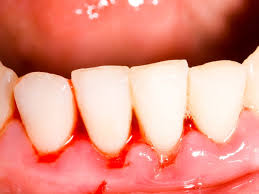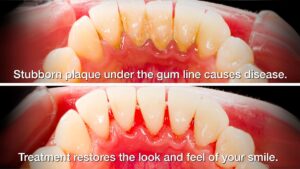Bleeding gums
Bleeding gums are a sign of gingivitis, or inflammation of your gum. It’s a common and mild form of gum disease, and it’s caused by a buildup of plaque at your gum line.
If you have Bleeding gums, your gums may be irritated, red, and swollen. They may bleed when you brush your teeth.
You can get rid of this problem by taking good care of your teeth. Brush your teeth twice a day .
If Neglected :-
If you don’t take care of your Bleeding gums , it can lead to periodontal disease, or periodontitis, a long-term gum condition that damages the tissue and bone that support your teeth.
If you have Bleeding gum , your gum may become inflamed and infected and pull away from the roots of your teeth if neglected.
When your gums bleed easily, it could be a sign of periodontal disease. Your teeth may get loose or separate. You could also get bad breath, a bad taste in your mouth, a change in how your teeth fit together when you bite, and red, swollen, tender gums.
Causes of bleeding Gum :-
Bleeding gums are most often caused by harmful plaque and the millions of bacteria in it found at or around the gum line being left to develop bleeding gum. Gingivitis, a mild form of gum disease, may require treatment and improved oral hygiene to help eliminate bleeding gum. If left untreated, bleeding gum and gingivitis can lead to a more serious form of gum disease called periodontitis.
Everyone experiences some form of plaque buildup. The saliva, bacteria, and proteins in your mouth form a thin layer that covers your teeth at almost all times. When you eat, tiny particles, acids, and sugars from the food stick to this film, creating a buildup on the teeth known as plaque. The bacteria that lives in this plaque can cause Bleeding gum and tooth decay.
TREATMENT FOR BLEEDING GUMS
 Bleeding gum can become a serious problem when left untreated.
Bleeding gum can become a serious problem when left untreated.
Methods for the prevention and treatment of bleeding gum:-
Brush for two minutes, twice daily. Try not to brush too hard and use a circular or elliptical motion around your mouth. It is recommended to replace your toothbrush every 3 months.
Flossing or using interdental brushes can help remove food particles and plaque bacteria from hard to reach areas, such as in between your teeth. Floss twice daily, ideally just before you brush your teeth.
If you see bleeding in your spit when you brush or experience any other possible signs of Bleeding gum, speak to your dentist as soon as possible. But don’t wait for there to be a problem before acting. Attending regular dental check-ups can help you identify and treat Bleeding gum symptoms before they get worse.
Profession Cleaning called Scaling
If your dentist has diagnosed you with gum disease, you should go for profession cleaning called scaling. for bleeding gum Scaling is a common dental procedure for patients with bleeding gum . This is a type of dental cleaning that reaches below the gum line to remove plaque buildup. The process of scaling and root planning the teeth is often referred to as a deep cleaning. This treatment goes beyond the general cleaning that you receive with your regular checkup and annual visit.
Regular Dental Checkup for bleeding gum :-
Regular dental cleanings will help remove the plaque and prevent more serious problems.
If you have healthy gums, the tissue will fit tightly around the tooth and keep plaque out. However, if gum disease begins to form, this tissue will loosen. Healthy gums attach to the tooth just 1 to 3 millimeters below the gum line.
If you have pockets of 4 millimeters or more, your dentist will probably recommend dental scaling to remove the plaque beneath the gum line and help treat the bleeding gum .
Dental scaling involves the careful removal of plaque bacteria from the tooth’s surface just below the gum line.
your dentist may choose an ultrasonic instrument to scale your teeth. This features a vibrating metal tip combined with a cool water spray. The tip chips tartar away as the water flushes out the pocket.
This results in healthy, bleeding free, bad breath free gums .